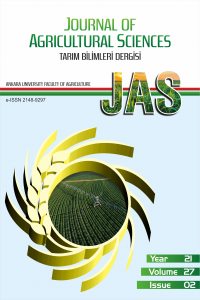Inheritance of Indehiscent Capsule Character, Heritability and Genetic Advance Analyses in the Segregation Generations of Dehiscent x Indehiscent Capsules in Sesame
Inheritance of Indehiscent Capsule Character, Heritability and Genetic Advance Analyses in the Segregation Generations of Dehiscent x Indehiscent Capsules in Sesame
Capsule shattering, Genetic parameters Mutation, Pleiotropy,
___
- Ashri A (1998). Sesame breeding. Plant Breeding Reviews 16: 179-228
- Ashri A (2007). Sesame (Sesamum indicum L.). In: R J Singh (Ed), Genetics Resources, Chromosome Engineering and Crop Improvement, Vol.4, Oilseed Crops, CRC Press, Boca Raton, pp. 231-289
- Chowdhury S, Datta A K, Saha A, Sengupta S, Paul R, Maity S & Das A (2010). Traits influencing yield in sesame (Sesamum indicum L.) and multi locational trials of yield parameters in some desirable plant types. Indian Journal of Science and Technology 3: 163-166
- Govidarasu R, Rathinam M & Sivasubramania P (1990). Genetic variability in sesamum (Sesamum indicum L.). The Madras Agricultural Journal 78: 450-452 Hahm T S, Park S J & Martin L Y (2009). Effects of germination on chemical composition and functional properties of sesame (Sesamum indicum L.) seeds. Bioresource Technology 100: 1643-1647
- Harikumar K B, Sung B, Tharakan S T, Pandey M K, Joy B, Guha S, Krishnan S & Aggarwal B B (2010). Sesamin manifests chemopreventive effects through suppression of NF-KB-regulated cell survival, proliferation, invasion and angiogenic gene products. Molecular Cancer Research 8: 751-761
- Hika G, Geleta N, Jaleta Z (2015). Genetic variability, heritability and genetic advance for the phenotypic traits in sesame (Sesamum indicum L.) populations from Ethiopia. Science, Technology and Arts Research Journal 4: 20–26
- Hoballah A A (2001). Selection and agronomic evaluation of induced mutant lines of sesame. In: Van Zanten L. (ed.): Sesame Improvements by Induced Mutations, Proc. Final FAO/IAEA Co-ord. Res. Mtng. Vienna, IAEA: 137–149 IPGRI & NBPGR (2004). Descriptors for Sesame (Sesamum spp.), International Plant Genetic Resources Institute, Rome, Italy, and National Bureau of Plant Genetic Resources, New Delhi, India
- Kang C W (2001). Breeding sesame for diseases and shatter resistant high yielding varieties with induced mutations. In: L Van Zanten (Ed), Sesame Improvements by Induced Mutations, Proc. Final FAO/IAEA Co-ord. Res. Meeting, IAEA, Vienna, pp. 41-49
- Khan N U, Marwat K B, Hassan B, Farhatullah G, Batool S, Makhdoom K, Ahmad W & Khan H U (2010). Genetic variation and heritability for cotton seed, fiber and oil traits in Gossypıum hirsutum L. Pakistan Journal of Botany 42: 615-625
- Kumar S T (2010). Seed genetics in relation to seed yield sesame. In: D Bedigian (Ed), Sesame: The Genus Sesamum, Medicinal and Aromatic Plants-Industrial Profiles, CRC Press, Boca Raton, pp. 255-265
- Langham D G (1946). Genetics of sesame, III. “Open sesame” and mottled leaf. Journal of Heredity 37: 149-152
- Langham D R (2001). Shatter resistance in sesame. In: L Van Zanten (Ed), Sesame Improvements by Induced Mutations, Proc. Final FAO/IAEA Co-ord. Res. Meeting, IAEA, Vienna, pp. 51-61
- Langham D R & Wiemers T (2002). Progress in mechanizing sesame in the US through breeding. In: J Janickand & A Whipkey (Eds), Trends in New Crops and New Uses, American Society for Horticultural Science Press, Virginia, pp. 157-173
- Mahmood T, Turner M, Stoddard F L & Javed M A (2004). Genetic analysis of quantitative traits in rice (Oryza sativa L.) exposed to salinity. Australian Journal of Agricultural Research 55: 1173-1181
- Smith J D & Kinman M L (1965). The use of parent-offspring regression as an estimator of heritability. Crop Science 5: 595-596.
- Steel R G D & Torrie J H (1980). Principles and procedures of statistics: A biometrical Approach. McGraw-Hill, New York
- TSMS (2010). Turkish State Meteorological Service. http://www.dmi.gov.tr/en-US/forecast-cities.aspx?m=ANTALYA. (Erişim tarihi:10.10.2015)
- Uzun B, Lee D, Donini P & Cagirgan M I (2003). Identification of a molecular marker linked to the closed capsule mutant trait in sesame using AFLP. Plant Breeding 122: 95–97
- Uzun B, Ozbas M O, Canci H & Cagirgan M I (2004). Heterosis for agronomic traits in sesame hybrids of cultivars x closed capsule mutants. Acta Agriculturae Scandinavica, Section B - Soil and Plant Science 54: 108-112
- Van Zanten L (2001). Sesame improvement by induced mutations: Results of the co-ordinated research project and recommendation for future studies. In: L Van Zanten (Ed), Sesame Improvements by Induced Mutations, Proc. Final FAO/IAEA Co-ord. Res. Meeting, IAEA, Vienna, pp. 1-12
- Weiss E A (1971). Castor, sesame and safflower. Barnes and Noble Inc, New York
- Yol E, Karaman E, Furat S & Uzun B (2010). Assessment of selection criteria in sesame by using correlation coefficients, path and factor analyses. Australian Journal of Crop Science 4: 598-602.
- Yol E, Toker C & Uzun B (2017). Inheritance of long and dense capsule characteristics in sesame. Turkish Journal of Field Crops 22: 8-13.
- ISSN: 1300-7580
- Yayın Aralığı: Yılda 4 Sayı
- Başlangıç: 1995
- Yayıncı: Ankara Üniversitesi
Khadijah MAKHDOOM, Naqib Ullah KHAN, Shahid Ullah KHAN, Rozina GUL, Zarina BIBI, Samrin GUL, Sardar ALI, Shah Masaud KHAN, Naushad ALI
Saqib Ali, İshrat NAZ, Muhammad ALAMZEB, Mamoon URRASHİD
Müge HENDEK ERTOP, Rabia ATASOY
An Approach to Color Change and Quality Relation in Roughages
Jale KORUN, Mesut YILMAZ, Mehmet GÖKOĞLU, Yağmur ÇELİK
Production of Double Haploid Plants Using In Vivo Haploid Techniques in Corn
İlhan TURGUT, 2. duran ZARARSIZ, 3. semra YANIKOĞLU, 4. leyla ÖZTÜR AKAR, 5. sezgin KIZIK, 6. burak BİLGİN
Fatemeh BAREKATİ, Eslam MAJİDİ HERVAN, Amir Hossein SHİRANİ RAD, Ghorban NOOR MOHAMADİ
Use of Principal Coordinate Analysis for Measuring GE Interactions in Rain-Fed Durum Wheat Genotypes
Ali Asghari, Rahmatollah Karimizadeh, Rahim Chinipardaz, Omid Sofalian, Abdolali Ghaffari, Kamal Shahbazi, Tahmasb Hosseinpour, Hassan Ghojog, Mohammad Armion
Anatomical Analysis of Graft Compatibility in Some Almond ScionRootstock Combination
Başak Özdemir, Ajlan YILMAZ, Hatice Nurhan BÜYÜKKARTAL, Yeşim OKAY
